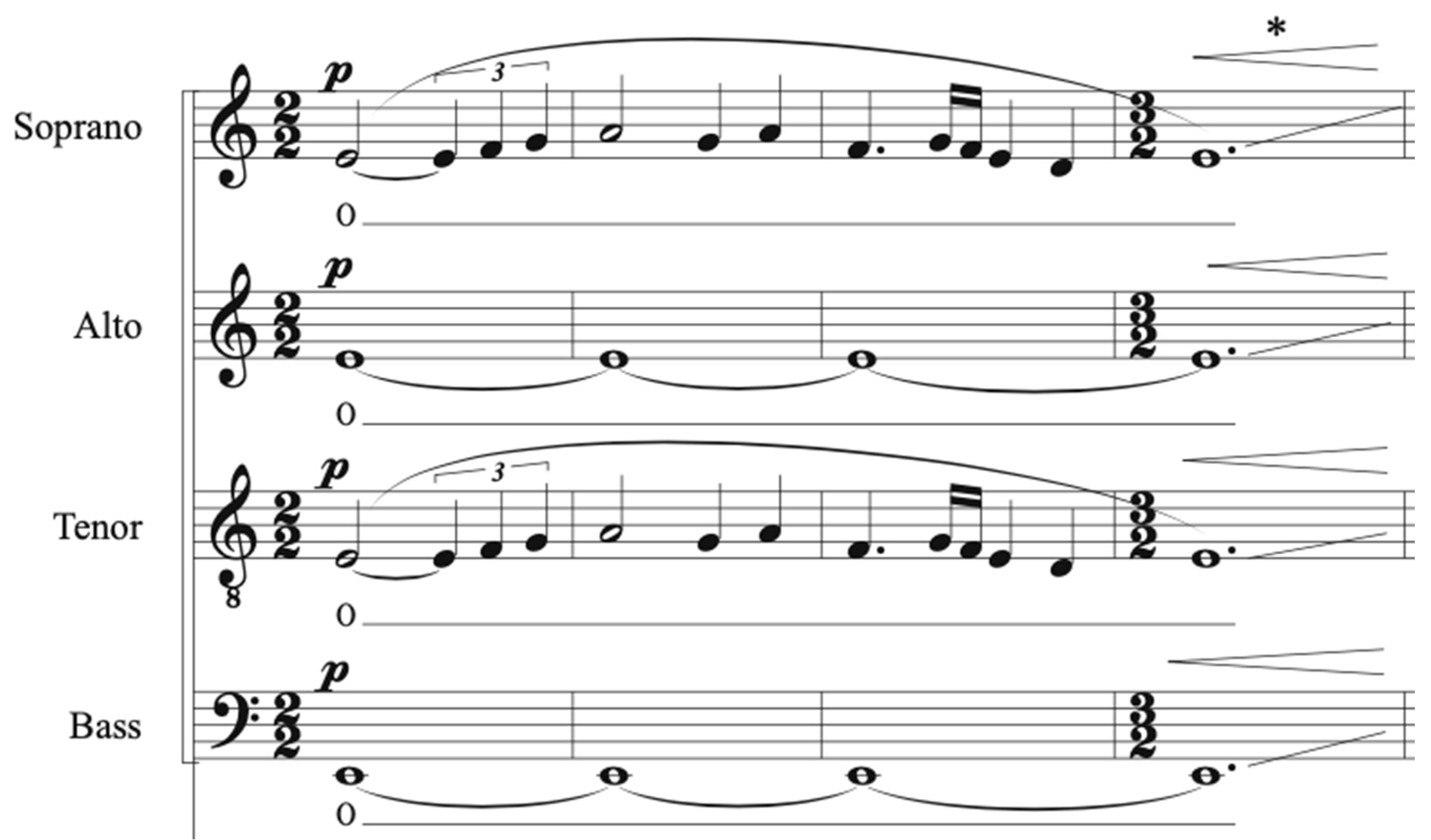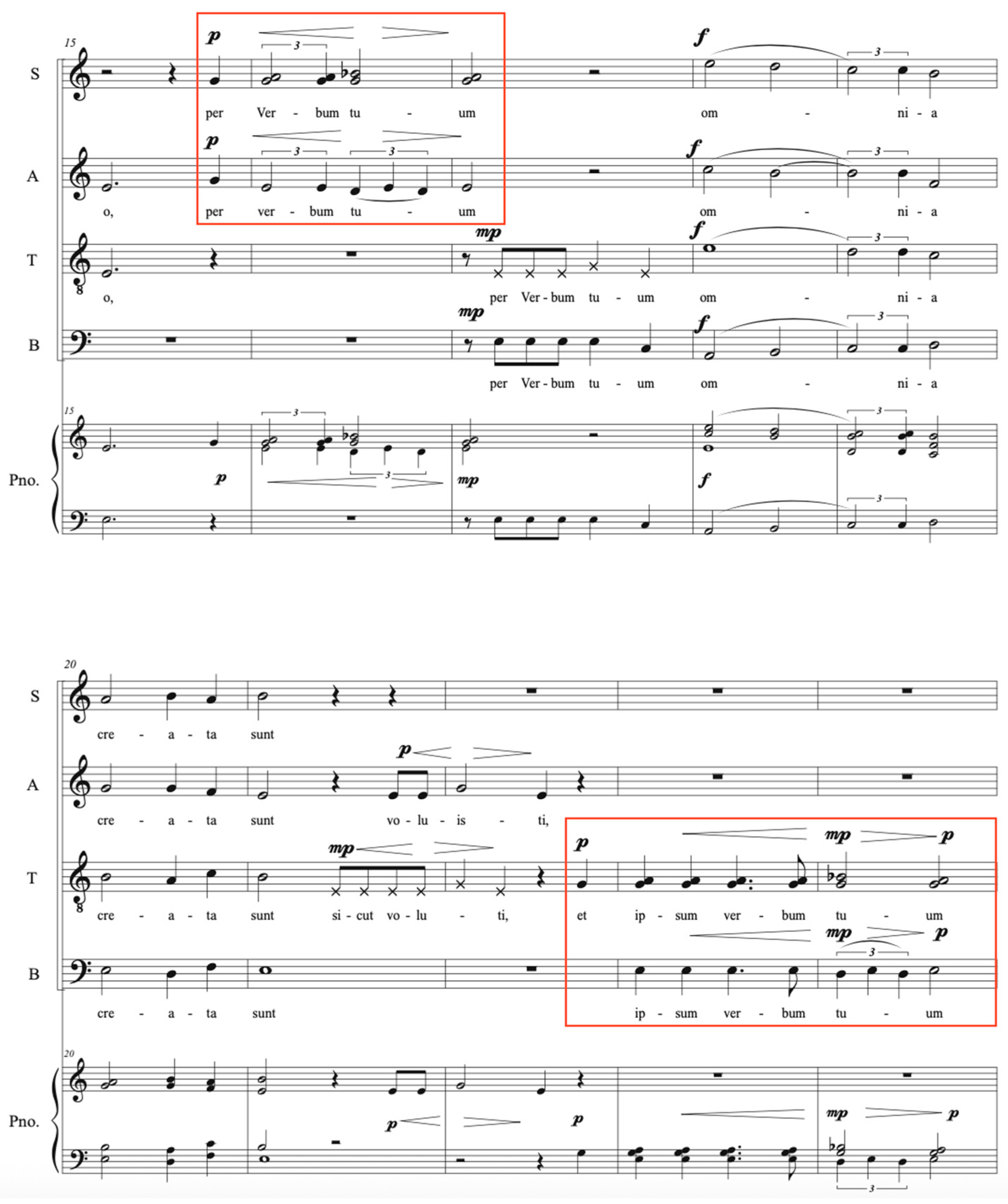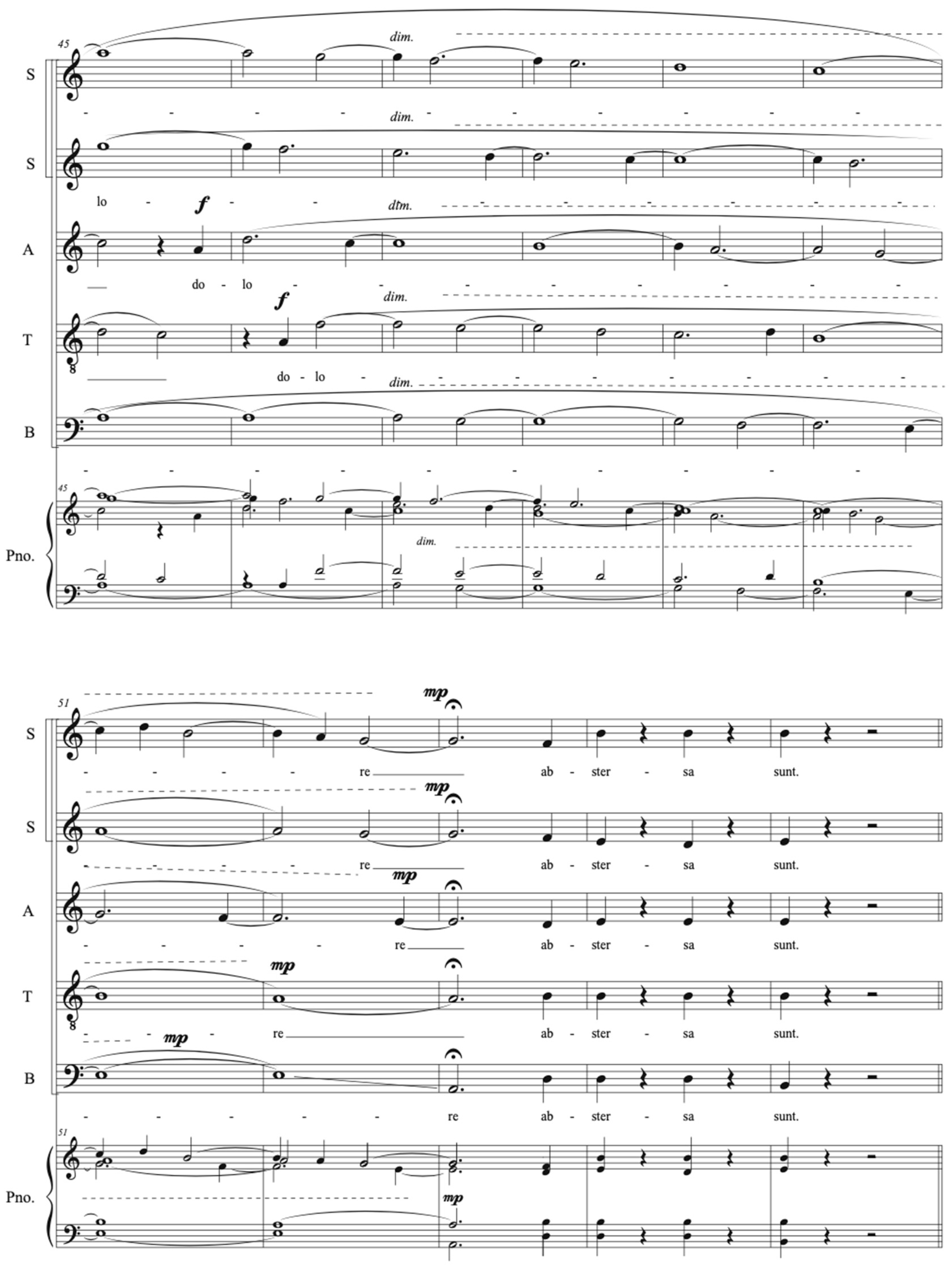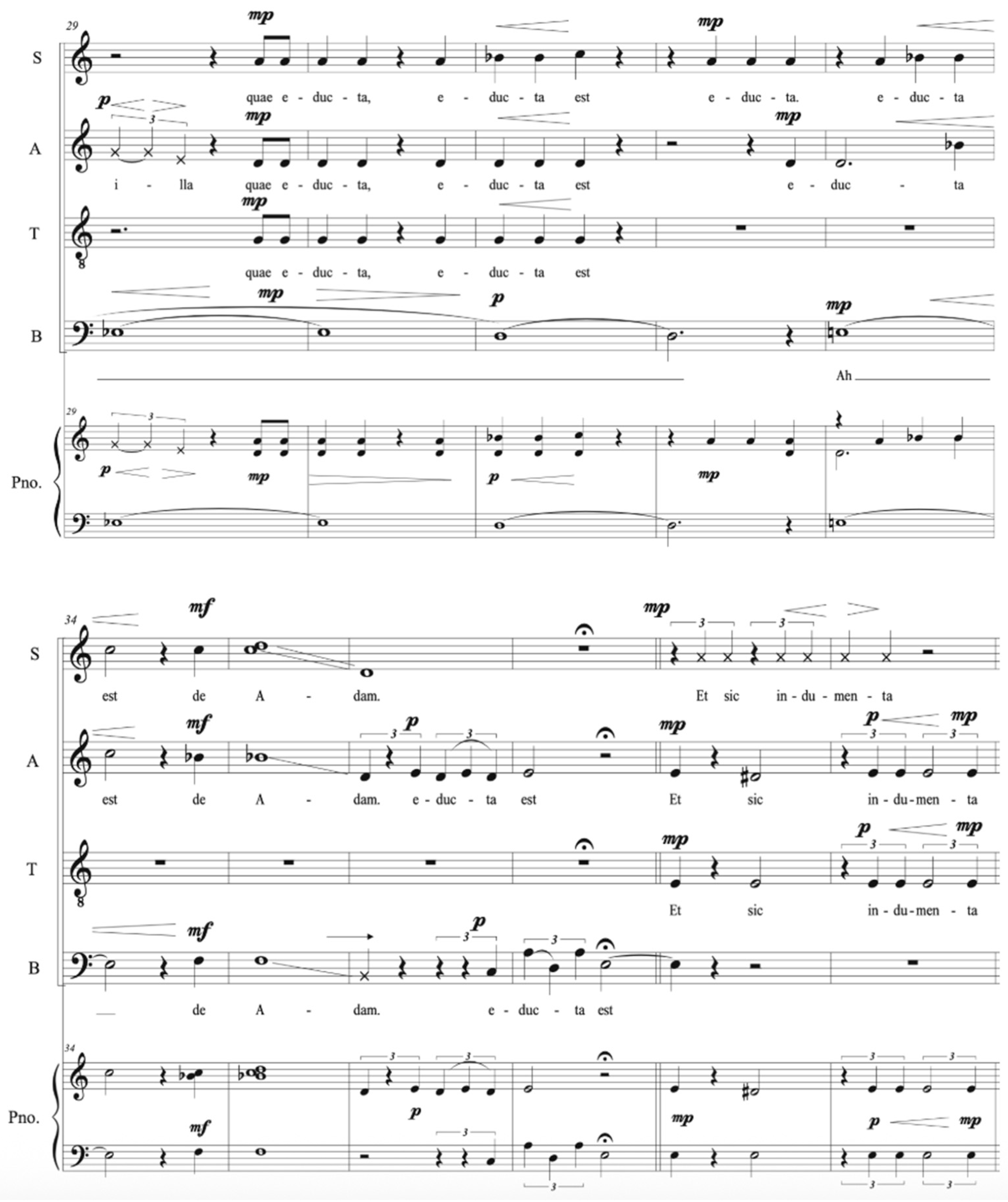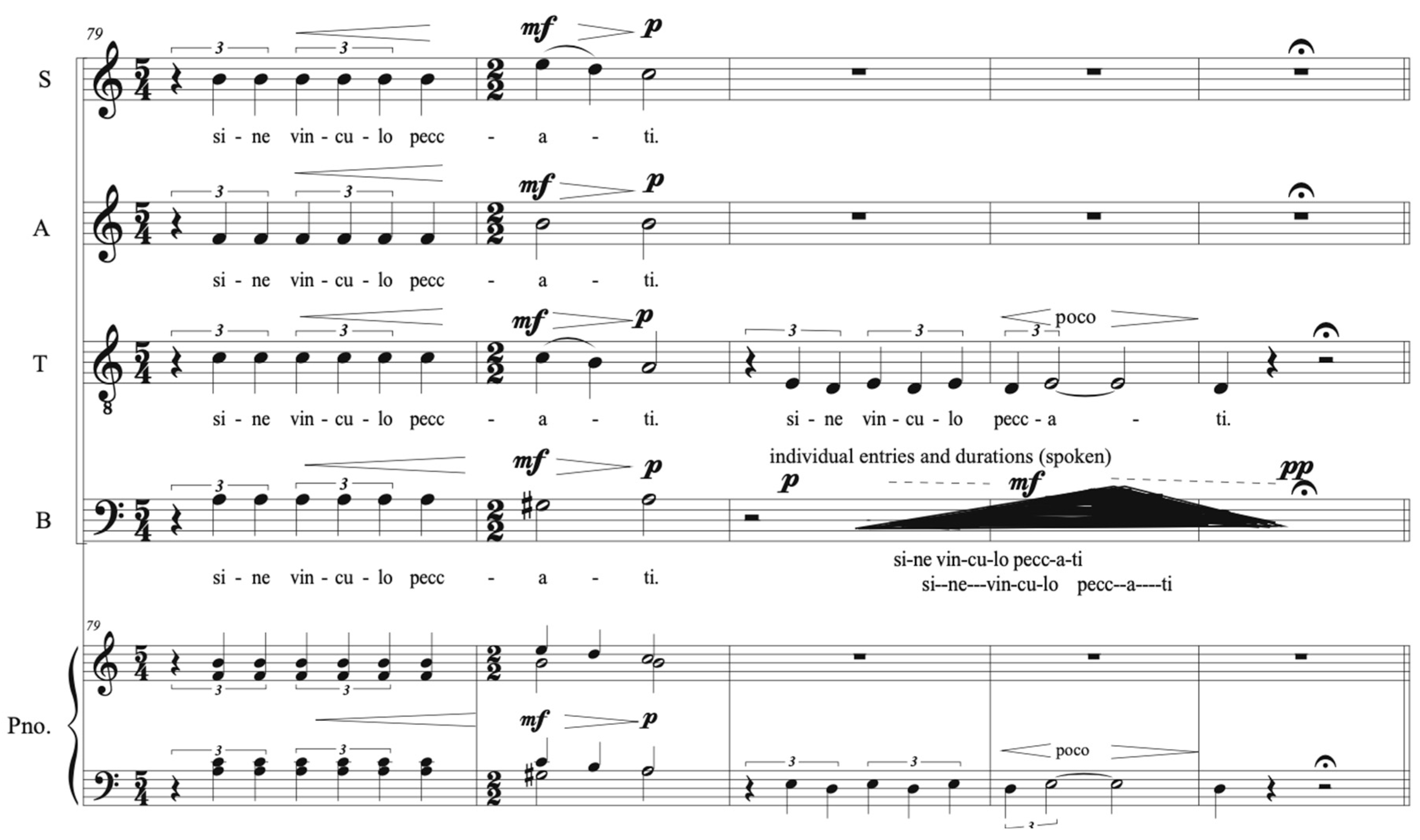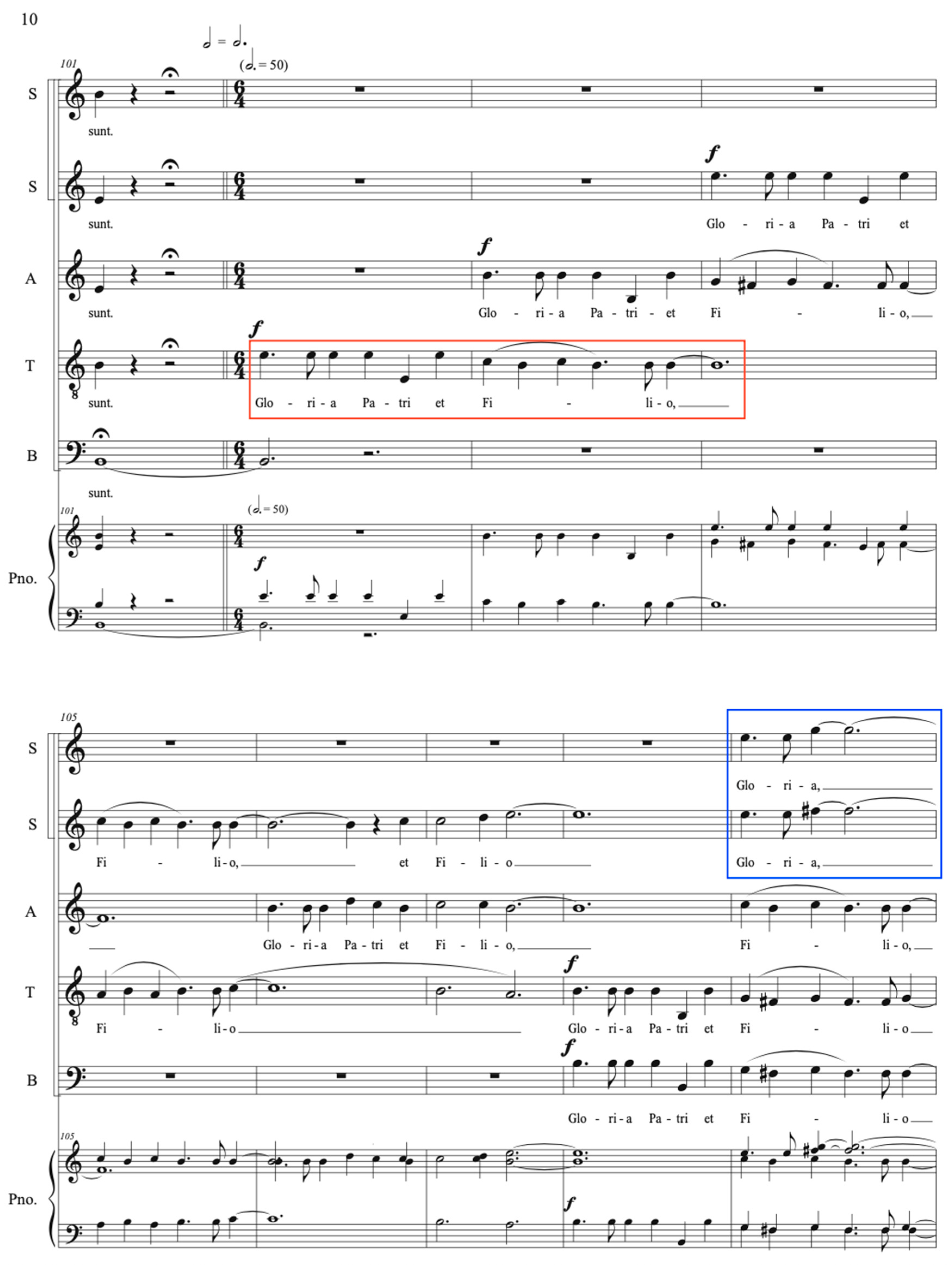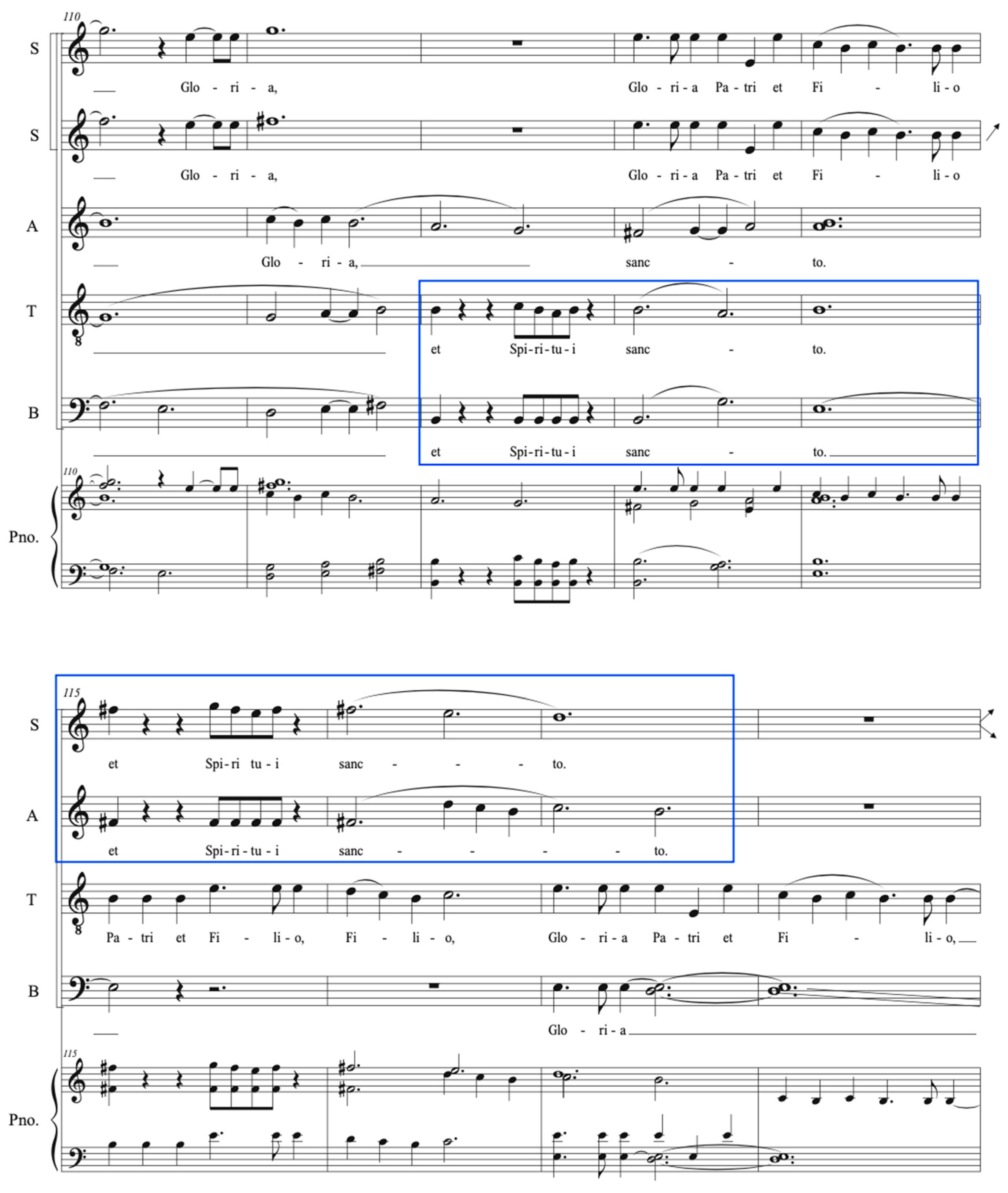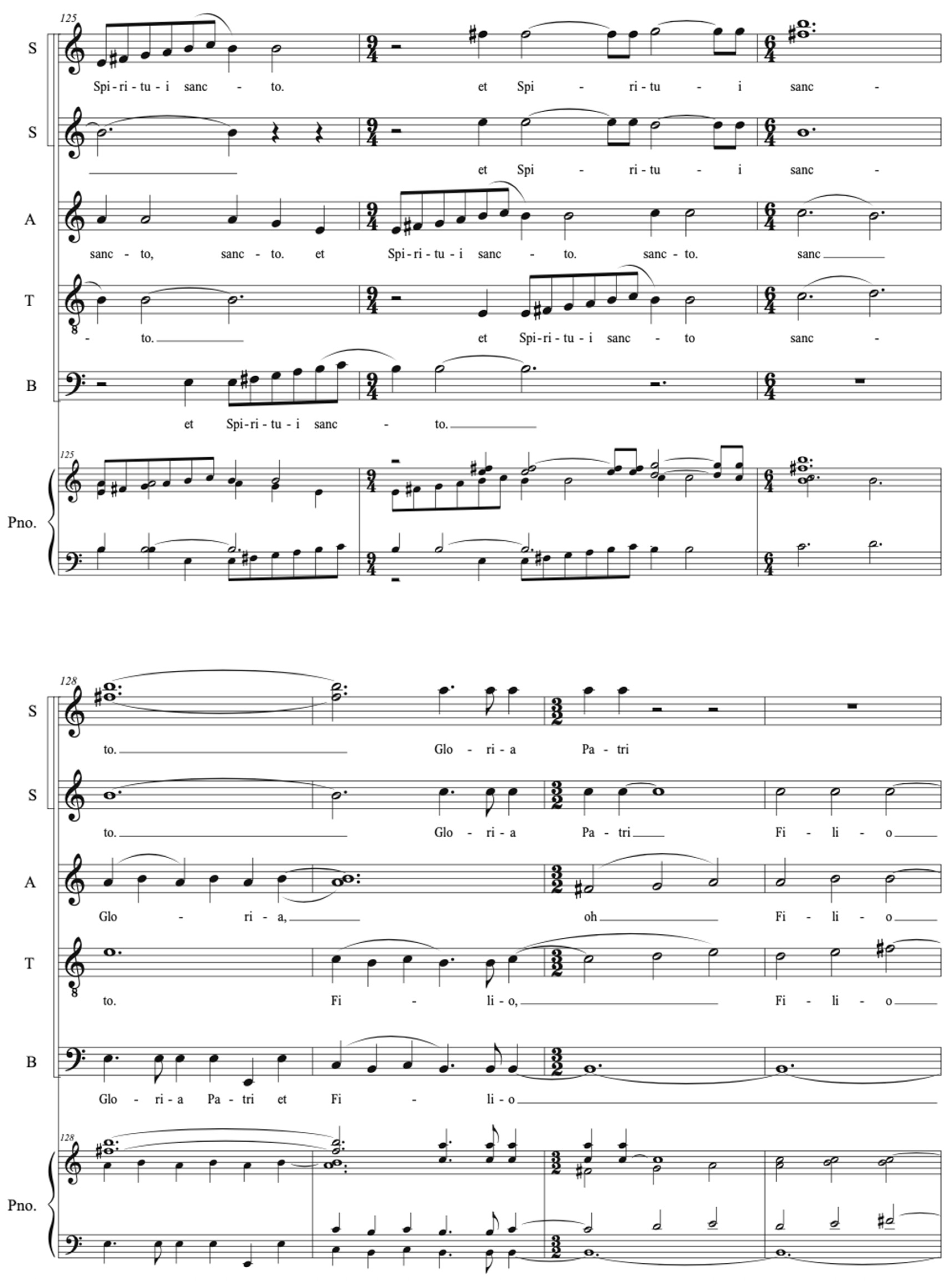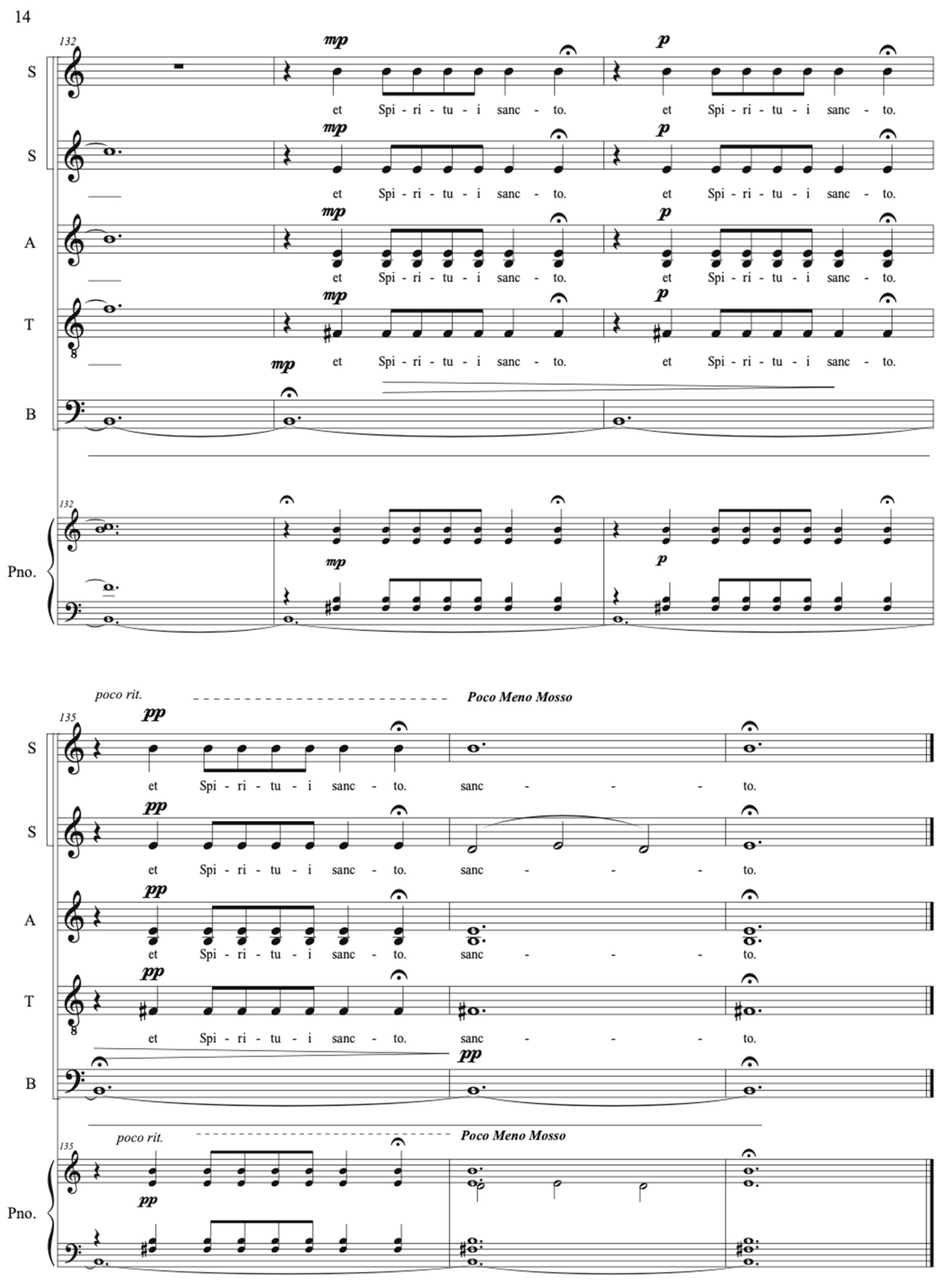3.1. Melodic, Harmonic, and Textural Structures
It is evident from the opening bars of the music that the powerful character of the text is a commanding factor in Clarke’s
O Vis Aeternitatis. The composer foregrounds the visceral spirit of Hildegard’s words through her textural and harmonic organisation of the music. She uses the gradual expansion of texture, antiphonal techniques, dissonant harmonic language, and contrasting vocal timbres to spotlight moments of dramatic escalation and spiritual importance in the text. The measured intensification of musical parameters is immediately apparent in the introduction of the work, which sets the titular text ‘
O Vis Aeternitatis’ (‘O Power of Eternity’; bb. 1–9). Clarke draws closely on Hildegard’s Phrygian melody, opening the piece with a four-bar melisma that begins and ends on a unison E, reflecting the original chant (
Figure 1). The composer has overtly acknowledged how Hildegard’s melody, with the ‘beautiful melisma on ‘O’ […] very definitely influenced the opening of this particular setting’ (
Music for Galway 2020a). Quotation of chant is a common feature of sacred choral composition across the ages and continues to serve as a stimulus for contemporary composers in the formulation of content and structure. As Scottish composer James MacMillan asserts in relation to plainchant and other historical music, composers ‘have always taken fragments of material […] from elsewhere and breathed new life into them, creating new forms, new avenues and structures of expression’ (
MacMillan 2000, p. 22). Clarke explains how the opening ‘O’ is a form ‘of expressing wonder […] This power that’s beyond our comprehension. A reverence in it for something that is far greater than human beings’ (
R. Clarke 2025). Clarke’s interpretation calls to mind Jonathan Arnold’s assertion that music can ‘help us to perceive the reality and mystical truth of something greater’ than ourselves (
Arnold 2019, p. 335).
The ‘O’ vowel enables a fluid melismatic line, reflecting Clarke’s attraction to the sound of the Latin words and ‘how well their open vowels suit the voice’ (
Fitzgerald 2022). The soprano and tenor present the opening phrase in unison, accompanied by the alto and bass’s E drone, a further emulation of early music and establishment of E as the tonal centre (
Figure 2). The Phrygian quality of the melody generates an intense, otherworldly sound through its minor second beginning, effectively capturing the mystery of the beyond. Furthermore, as Jeremy Begbie describes, the presence of a drone in music represents ‘the eternal’; with chant, this sustained sound forms ‘an umbilical cord’ to the sacred’ (
Begbie 2000, p. 136). Clarke’s use of Hildegard’s opening chant, accompanied by a drone, evokes a sense of the spiritual and eternal, drawing the listener into her compelling sound-world.
Following the unison E in bar 4, each voice ascends with Clarke’s characteristic use of
glissando to form a
fortissimo E–B harmony, maintaining a sense of the archaic through the open fifth.
9 The voices proceed homophonically, with the phrase’s penultimate harmony creating a dissonance of two stacked fourths, B–E–C–F#, the soprano–alto tritone increasing the tension. Tenor and bass descend with
glissandi to the E–B fifth, while the upper voices resolve to an octave on E, avoiding a definitive tonality with the open harmony (bb. 8–9). Clarke employs vocal
glissandi to conjure an ‘otherworldly feeling’, further accentuating the power of the Divine in the text (
R. Clarke 2025). The introductory
piano melismatic phrase and succeeding
fortissimo homophony heard in the initial nine bars are restated at the beginning of the second verse (bb. 56–64), on a similar statement of veneration (
O quam magna est benignitas Salvatoris—‘O how great is the goodness of the Saviour’). According to Newman, a salient feature of Hildegard’s style ‘is her fondness for the grand gesture’, with the majority of her songs beginning with the ‘solemn apostrophe’—‘
O virga ac diadema’ or ‘
O victoriosissimi triumphatores’, for example, expressing awe at God’s power and grace (
Newman 1988, p. 40). Clarke’s repetition of the opening musical material highlights her manipulation of form and texture to indicate a new musical section, creating a sense of coherence, as well as to underline Hildegard’s continued influence on her setting, and moments of significance, most notably text that directly exalts the Divine.
A consistent harmonic feature throughout the work is the conclusion of phrases and sections with open chords, preserving the modal framework and avoiding conventional cadence points (
Table 1). The composer’s evasion of definitive tertian chords is a common trait throughout her oeuvre, with the use of open dyads particularly prevalent in her lower textures and in settings of medieval texts, such as Hildegard’s, and Christmas carols.
10 The intensification of dynamics from
piano to
fortissimo; the expansion of vocal register (E2–G5); and the contrasting open and dissonant harmonies, with
glissandi, in the introduction to both verses suggest that Clarke endeavoured to create an emotive, powerful sonority, highlighting the potency of the Divine, while foregrounding the
Abendmusik theme of combining the old and the new.
A significant aspect of Clarke’s textural approach in
O Vis Aeternitatis, as well as her other recent works such as
Ave Atque Vale (2017) and
It Matters (2021), is the barren, discordant tapestry of repeated and sustained notes, combined with
Sprechstimme, which gradually augments to align with the text’s dramatic development. Following the rousing Phrygian introduction, a textural shift occurs with a recitative-like phrase unfolding in the alto at a
piano dynamic, centred on E, with
Sprechstimme in the tenor and bass (bb. 10–12,
Figure 3). The cross-headed notation within the work alternates between recitation of repeated E tones and minor third undulations between E and G, which should be ‘varied […] as per natural speech inflections’ (
R. Clarke 2020). The sudden reduction in dynamics and texture to the alto’s unison singing, with timbral contrast provided by the lower voices’
Sprechstimme, distinguishes this section of text from the powerful introduction of adoration. While the syllabic recitation reflects the rhythm of plainchant, maintaining a sense of the past and an impression of prayer, the use of the contemporary vocal technique
Sprechstimme ensures the piece ‘sounds of our time’ (
R. Clarke 2025). Additionally, Clarke’s shift to unadorned unison singing engenders what Levy calls an ‘aura of authoritative control’ (
Levy 1982, p. 507)
11, highlighting her respect for ‘the sound of the words’, ensuring textual clarity throughout (
R. Clarke 2025).
Minimal alterations transpire in the melodic statement of ‘
que omnia ordinasti in corde tuo’ (‘By all things order in your heart’), with chromatic movement to neighbour tones, and alto and tenor conclusion on E in bar 15. This is followed by antiphonal dialogue between the upper and lower voices on the text ‘
per Verbum tuum’ (‘by your Word’) in bars 15 to 17 (
Figure 4), a common feature in Clarke’s wider output, creating timbral contrast within the bare texture. Clarke effectively expands the harmonic framework in the upper SSA texture with the sopranos’ unison G extending to a major second, and then a minor third interval, before contracting to a major second (G–A), with minimal melodic motion in the alto’s triplet undulation between E and D. This harmonic passage is imitated by the tenors and bass on the same text, ‘
Verbum tuum’, in bars 23 and 24, creating symmetry within the work and connecting the motif directly with the text, as well as generating a distinctive ‘Clarke’ sound with sung and spoken text in close proximity.
A return to SATB homophony occurs in bars 18 to 21 on ‘
omnia creata sunt’ (‘all was created’), the extension of the voices’ ranges and
forte dynamic accentuating the modification of texture. The contrary motion between the bass and upper voices on the melismatic first syllable of ‘
omnia’ demonstrates Clarke’s idiomatic choral writing, with each part moving predominantly by step. The elongation of the open vowel is a further indication of Clarke’s understanding of the inflection of the Latin language and her attraction to its natural sounds. The medieval choral sonority re-emerges in the conclusion of the phrase in bars 20 to 21, the tenor and bass moving in parallel open fifths (E–B; D–A; F–C), and concluding with a return to the open E–B harmony with soprano and alto, maintaining the E Phrygian modality. Clarke’s manipulation of the texture, from the preceding stark, almost monophonic framework to denser homophony at ‘
omnia creata sunt’ calls to mind Wallace Berry’s observation on the significance of such textural shifts: ‘Within structural segments both large and small, the rate at which texture changes in the course of progression and recession is a vital aspect of expressive effect’ (
Berry 1987, p. 201). All voices unite and progress in a homorhythmic manner, reflecting the declaration that ‘all’ was created by God. In a compositional era where, as composer Andrea Ramsey notes, ‘perhaps too great a percentage of our works comprise slow homophony’ (
Denney 2019, pp. 13–14), Clarke exhibits a continuous manipulation of texture, preserving complete homophony or busier counterpoint for significant moments in the text and music.
Mark Fitzgerald contends that ‘[S]inging out a word or phrase within the larger text for expressive expansion is a common compositional strategy’ in Clarke’s choral work (
Fitzgerald 2022). The composer herself asserts that ‘[W]hen you are setting a text, you cannot bring out every single thing […], so you must focus on very particular aspects’ (
Music for Galway 2020a). Within
O Vis Aeternitatis, Clarke states that she chose to spotlight the power of the opening line and the aspect of suffering in the refrain (
Music for Galway 2020a). The most literal communication of text in the work materialises on the phrase ‘
a maximo dolore, abstersa sunt’ (‘through greatest suffering, were cleansed’), outlining ‘the sorrow introduced by Adam’s sin’ (
Campbell and Lomer 2014), which was subsequently redeemed through Jesus’s human suffering (bb. 40–55; 87–101;
Figure 5). Following the dissonant, bare texture of repeated and sustained tones and
Sprechstimme, the
piano legato alto and tenor ascend melismatically in sixths on ‘
maximo’, gradually broadening the melodic range, in preparation for the impassioned, five-part discordant outburst on ‘
dolore’.
Forte octave leaps (A–A’) in quick succession in the first soprano and bass (bb. 43–44) instigate similar leaps across the texture,
12 embodying a cry of pain, with each voice’s subsequent stepwise descent at independent rhythmic intervals creating harsh suspensions that similarly evoke pain and suffering. Major and minor seconds between the sopranos, and soprano 2 and alto, create a jarring tone, before resolving to major and minor thirds. According to Clarke, her setting of the refrain is ‘very definitely an expression of pain […] The whole impetus there is on […] the idea of pain as a very visceral thing’ (
Music for Galway 2020a).
This dramatic display of dissonance, which gradually diminishes in dynamics to
mezzo-piano, concludes in bars 52 to 53, with the bass’s descending
glissando from E3 to A2 forming a sustained open A seventh chord at the end of the phrase. The lack of the third is a further indication of Clarke’s evasion of definitive tonality, preferring a modal sound world. A striking harmonic and textural contrast follows, with the homophonic utterance of ‘
abstersa sunt’ (‘cleansed’) disjointed by crotchet rests between the chords. Tenor and bass repeat a major sixth (D–B) interval below the alto and sopranos’ minor third (D–F), which expands to a fifth (E–B), and then a tense D–E–B chord, before returning to the fifth, all voices forming an open B–E–B harmonic conclusion. The tenor and first soprano’s repeated B, and alto’s repeated E, with minimal movement in the other voices, create a sense of melodic stasis, the stark harmonies patently contrasting with the previous texturally dense dissonance. The wider intervals and crotchet rest punctuation may be interpreted as illustrating the cleansing of Jesus’s ‘garments’, or body, purifying the tonal palette following the jarring suspensions in the choir’s expression of ‘greatest suffering’. The subsequent three-beat silence intensifies the conclusion of this section and the emotive weight of the text. Theorist Robert Hines contends that ‘[t]he importance of silence should not be underestimated; it is a strong, malleable ally when developing musical ideas’ (
Hines 2001, p. 69). Clarke’s application of extended rests prolongs the tense atmosphere of the preceding discordant outburst, while also allowing respite before the beginning of a new section. Furthermore, the silence is imbued with a spiritual quality, not unlike the sacred music of Arvo Pärt (b. 1935), who employed rests between phrases and sections to allow the listener to ‘absorb the aural and spiritual impact of the moment’ (
Muzzo 2008, p. 30).
3.2. Self-Allusion: Connecting Sound and Emotion
In addition to Clarke’s paraphrasing of Hildegard of Bingen’s chant within
O Vis Aeternitatis, it can be argued that the composer has alluded to her own previous writing, specifically in the first verse. The melodic, harmonic, and textural structures of another of Clarke’s pieces,
Ave Atque Vale (2017), exhibit distinct similarities to
O Vis Aeternitatis, most notably the sparse tonal and textural framework, as well as the inclusion of
Sprechstimme. Whether this self-allusion is deliberate or mere coincidence is uncertain, but an analysis of her compositional approaches in both works can help to elucidate this matter. In bars 29 to 36 of
O Vis Aeternitatis, the soprano repeats A, rising and falling through B♭ and C through ‘
que educta est’ (‘drawn from’), before culminating in a stepwise ascent to a secundal C–D interval on ‘
Adam’. This ascent is accompanied by a fragmented pattern of G–D fifths in the tenor and alto, supported by an E♭ moving to D in the bass. The apex of this section features a cluster of B♭, C, and D in the alto and sopranos with F in the bass, descending through
glissandi to a unison D with
Sprechstimme B in the bass (
Figure 6). This section relates to the Incarnation of Jesus, culminating in the upper tone cluster and descending
glissandi through the first syllable of ‘
Adam’, which is followed by undulating seconds (E4–D4) in the alto on ‘
educta est’, echoed by the bass in wider intervals (C3–A3–D3–A3–E3). According to Campbell and Lomer, Hildegard’s ‘pairing of Adam—the first human, whose Fall broke […] creation—and Christ—the God-human, whose Incarnation restored it—is commonplace in Christian thought, rooted in the writings of St. Paul (e.g., Romans 5:12–21 and 1 Corinthians 15:21–50)’ (
Campbell and Lomer 2014). Although Clarke has stated that she was not drawn to the theological or doctrinal aspects of the text (
Music for Galway 2020a), the gradual stepwise ascent to a tone cluster and subsequent
glissando descent are highly dramatic and could be interpreted as a depiction of Adam’s Fall.
It is striking that in the piece
Ave Atque Vale,
13 Clarke uses notably similar textural and harmonic language to that in the above passage from
O Vis Aeternitatis. The text of
Ave Atque Vale, by the Roman poet Catullus (c. 84–54 BCE), is an elegy addressed to his brother, who was killed in war. In Clarke’s setting, she pursues a minimalist approach to developing intensity while capturing the despondent mood of the text. Textural density and dynamics gradually expand in tandem with the increasingly dissonant language, conveying the growing despair of Catullus as he bids farewell to his brother. The music thus reflects Peter Sacks’s interpretation of an elegy as having ‘a measured pace and direction’, like a funeral procession (
Sacks 1987, p. 19). At bar 29, the soprano follows an almost identical trajectory to
O Vis Aeternitatis, gradually ascending from A to D, supported by the fragmented open G–D fifths in the tenor and alto, and an E♭ pedal tone in the bass (‘
Quandoquidem fortuna mihi tete abstulit ipsum’
—‘Inasmuch as fate takes you, even you, from me’). The climax of this subsection is signalled by the shift to a sustained F in the bass, while the sopranos ascend to a secundal
divisi (C–D), creating a tone cluster with the alto’s B♭ on ‘
ipsum’ at a
forte dynamic (b. 40). This tense sonority of close intervals in the upper texture, creating a B♭ ninth in second inversion, dissipates in a descending
glissando in the soprano and bass, perhaps representing Catullus’s outpouring of grief, with all voices then resolving to D (
Figure 7).
The texture and harmonic language are practically indistinguishable in the above excerpts, and both gradually build in intensity through rising dynamics and pitch. While the respective moments in question differ greatly in text and narrative content, both convey a notably dramatic character, which likely prompted Clarke to use almost identical musical elements. These moments of heightened drama demonstrate how Clarke’s compositional palette is applied to diverse texts and in different contexts to create an emotive, impassioned sound. Considering the timeframe within which these works were composed,
Ave Atque Vale was one of Clarke’s first choral works to feature extended vocal techniques, which, she says, followed from similar approaches in her instrumental work
SHIFT (2013) (
The Contemporary Music Centre 2022), and
O Vis Aeternitatis was one of the first choral pieces she wrote after
Ave Atque Vale. While she has not referred specifically to the excerpts highlighted above, Clarke has stated that her setting of Hildegard’s text ‘came out of the experience with
Ave Atque Vale’ (
R. Clarke 2025). Her utilisation of strikingly similar harmonic and textural elements across these diverse sacred and secular works reveals a coherence of compositional voice, as she employs similar intensifying sonorities at emotionally powerful points in each piece.
3.3. Extending the Timbral Palette
Both
O Vis Aeternitatis and
Ave Atque Vale feature extensive use of
Sprechstimme and
glissandi, intensifying their dramatic sound worlds. Their application of contemporary choral techniques reflects Clarke’s desire to ‘create something that I have not heard before, either as a listener or as a composer’ (
Chamber Choir Ireland 2023). An overview of Clarke’s choral output since 2016 reveals an increased exploration of vocal timbre, highlighting further development of her compositional voice. These extended techniques in themselves are not new within contemporary choral music, with ‘
Sprechgesang, shouting and whispering, laughter and crying, glissandi, […] sound production through inhalation and exhalation, vowel morphing, […] and nonsense syllables or phonemes’ being used by composers as a means of word painting and emotional expression (
Crump 2008, pp. 3–4). Irish contemporaries such as Siobhán Cleary and Michael Holohan, as well as international composers such as Jaakko Mäntyjärvi, Jake Runestad, Katerina Gimon, and Caroline Shaw, incorporate extended vocal techniques into their choral works, continuing to diversify the performances of choral ensembles. These contemporary devices are used in a variety of ways, expanding composers’ creative and expressive toolkits while evoking the atmosphere of the texts that they set. However, their presence in sacred repertoire is relatively rare, particularly with regard to
Sprechstimme.Following brief forays into the use of extended techniques in
Gloria (1989) and
A Song for St Cecilia’s Day (1991, rev. 2020), Clarke began to integrate these devices consistently into her choral language after her instrumental work
SHIFT (2013), which experimented with extending the parameters of instruments’ sounds and contrasting orchestral colours as ‘blocks of sound’ (
R. Clarke 2014).
14 In the period surrounding
SHIFT, Clarke observed how ‘[A] ‘shift’ in language and style has emerged gradually in my own work resulting from, amongst other things, a return to electro-acoustic processes’ (
R. Clarke 2014). In addition, she professes her attraction to ‘visual and musical works, which are bold and have confident strokes’, thus seeking to achieve this in her own musical language (
R. Clarke 2014). As Clarke regularly composes for choirs of a high technical and expressive standard, such as Resurgam, which premiered
O Vis Aeternitatis, and State Choir Latvija, opportunities to expand the timbral palette and textural complexity within her music are extensive. However, Clarke’s judicious compositional decisions, particularly in integrating extended vocal techniques, render her works accessible across a range of technical levels.
Having previously been reluctant to explore extended techniques in her choral settings, with minimal use of
Sprechstimme only evident in
A Song for St. Cecilia’s Day, Clarke began to combine ‘more speech patterns […], almost half-sung patterns’ with conventional vocals in pieces such as
The Old Woman (2016),
Ave Atque Vale, and
It Matters (2021) (
The Contemporary Music Centre 2022). As well as the aforementioned influences on her shift in choral writing, Clarke has also attributed this combination of different sounds to an increased confidence in her work as she has become older, no longer caring ‘what people think’ (
RTÉ Lyric FM 2022). She further explains: ‘my thoughts on making something very definitely sound ‘of now’ might have triggered the use of extended techniques from […] 2016’ (
R. Clarke 2025). Her synthesis of diverse timbres and techniques has resulted in innovative sound worlds that effectively capture the tone of the set texts and demonstrate her distinct compositional voice, underlining her established reputation as ‘an original and integer composer’ (
Klein 2017).
The first instance of
Sprechstimme in
O Vis Aeternitatis occurs in the tenor and bass accompaniment of the alto’s almost monotone phrase ‘
per omnia ordinasti’ (‘by all things in order’) at a
piano dynamic in bars 10 to 12 (
Figure 8). This exposed texture occurs after the homophonic
fortissimo declamation of ‘
O Vis Aeternitatis’, offering a distinct contrast in terms of dynamics, timbre, and textural density. As is the case with her orchestral work
SHIFT, ‘[T]he concentration is on blocks of sound’ and opposites, which is apparent in the diverse, contrasting timbres within
O Vis Aeternitatis (
R. Clarke 2014). Following the presentation of the ‘old’—the traditional chant from Hildegard’s responsory addressing the ‘Power of Eternity’—the combination of the alto’s monotone syllabic text on E with the tenor and bass’s
Sprechstimme establishes the reverent tone in a contemporary light. As this was a commission for Music for Galway’s ‘Resounding Landscape’ concert, it is possible that Clarke wished to include sounds reflecting the concert’s theme through her use of different vocal timbres, as opposed to simply painting specific words or phrases within the text. The power of the Divine is illustrated through traditional compositional means, with the elaborate melismatic chant and
fortissimo homophonic declamation of praise, as well as the concluding fugal texture. In a more contemporary manner, Clarke combines extended vocal techniques with the chanting of text, reminiscent of psalm tone singing, in a stark texture that could be deemed to represent the mortal, earthly aspect of the text—those praising the Saviour (
Salvatoris) through prayer.
An effective use of aleatoric
Sprechstimme in the setting of the responsory occurs in the basses’ expression of ‘
sine vinculo peccati’ (‘without the chains of sin’) in bars 81 to 83. While the tenor undulates in crotchet triplets between E and D, the basses enunciate the words at ‘individual entries and durations’, the pitch direction and intensity indicated by a dense triangular graphic (
Figure 9). As is common with sectional conclusions in the work, Clarke has reduced the texture and dynamics, closing with a fermata. This ending allows the spoken text to resound before the return of the refrain’s more structured, yet initially bare, texture of a unison E and
Sprechstimme. The contrasting timbres and independent expression of text at the end of this verse effectively convey one uninhibited by the bondage of sin; the tenor and bass voicing likely representing the figure of Jesus. This significant moment is further underlined given its occurrence immediately after a homophonic SATB declamation of the same text. The prolonged rest that follows the indeterminate spoken text also allows the voices to echo before proceeding to the new phrase, creating a distinction between the verse and response. The use of surging collective speech at individual
tempi for ‘
sine vinculo peccati’ could be interpreted as the sound of chains, and then those chains falling away (
mf reducing rapidly to
pp), thus freeing all from sin (‘
omnia liberavit’). Clarke reserves this swelling aleatoric spoken text, solely in the lowest voices, for this extraordinarily literal and significant moment expressing the core Christian belief that Jesus was born without sin in order to save humanity (2 Corinthians 5:21; 1 John 3:5).
3.4. Polyphonic Expression of Devotion
In what could be deemed a significant change of character from the preceding refrain, the culmination of Clarke’s manipulation of texture occurs in the final section of
O Vis Aeternitatis, with the fugal setting of the doxology ‘
Gloria Patri et Filio’ (‘Glory be to the Father and to the Son’; bb. 102–132). The tenor introduces the
forte E Aeolian subject in 6/4, fluctuating across the octave between E4 and E3 on ‘
patri et’, before oscillating a semitone between C and B on ‘
Filio’ (‘Son’). The alto presents the answering phrase a bar later on the dominant B, reflecting the conventions of fugue writing (
Figure 10). The melodic undulation in minor (and major) seconds is a compositional trait applied frequently across Clarke’s oeuvre, the composer acknowledging her fondness for the tense, clashing sound of the adjacent notes (
R. Clarke 2025).
15 More broadly, musicologist William Kimmel notes how the minor second interval in music ‘possesses greater energy and intensity and consequently internal momentum which in melodic progression accelerates in the direction of the second tone’ (
Kimmel 1980, p. 46). Within the fugue of Clarke’s piece, the melodic oscillation embellishes the first syllable of ‘
Filio’, recalling the melismatic introduction of both verses. This feature also helps to propel the unceasing melodic motion and exultant character of the fugue, a striking contrast to the predominant chant-style recitation and dissonant tension of the preceding exposed homophony.
The contrapuntal texture continues to expand with the second soprano and bass entries in bars 104 and 108, respectively. Unlike the previous sections of prolonged rests, there is no respite within the fugue, with an incessant progression of interweaving phrases across the five-part texture. Both sopranos introduce a rising ‘Gloria’ counter-subject in bar 109, increasing the complexity of the counterpoint and spirited atmosphere of the fugue. Both voices begin on E5, before sustaining a minor second dissonance of F#–G on the final syllable for seven beats. This motif is repeated in the same voices in bars 110 and 111, with the discord maintained for six beats. The secundal interval conveys a sense of coherence and tension throughout the work, with Clarke establishing the second as a salient harmonic and melodic feature from the outset.
Clarke has recalled how her decision to set this text of praise as a fugue was ‘intuitive’ and naturally suited the structure of the piece (
R. Clarke 2025). In composing her contemporary setting, Clarke recognised the doxology as a separate component of Hildegard’s text (
R. Clarke 2025). From a theological perspective, the doxology is a separate prayer, not originally composed by Hildegard; the doctrine of the Trinity is a central facet of the Christian faith, formally articulated in the Nicene Creed of 325 CE. Clarke effectively demonstrates this textual distinction through the transition to a lively contrapuntal framework that contrasts with the predominantly homophonic textures of the preceding music. The textural transformation, as well as the shift in mood, modality, and metre at this point, imply the composer’s sensitivity to the distinction between Hildegard’s text and the pre-existing doxology. The religious and historical significance of the doxology is well known, certainly to someone of Clarke’s cultural milieu, and it is plausible that her awareness of its distinct theological identity impacted her compositional and structural decisions in this section. In any case, the juxtaposition of the historical fugal form with the harmonic and timbral boldness of Clarke’s more contemporary characteristics points to the eclectic nature of her compositional style.
Clarke’s decision to include a fugue may also have been influenced by the commission’s context. As Music for Galway’s Abendmusik series was inspired by its seventeenth-century German counterpart, and the premiere performance of O Vis Aeternitatis featured alongside Baroque sacred works by Purcell and Handel, Clarke may have intended to reflect this era through her intricate polyphonic counterpoint. While fugues are occasionally used by contemporary composers such as James MacMillan (b. 1959), John Rutter (b. 1945), and Eoghan Desmond (b. 1989), such writing is not a prevalent feature in Clarke’s overall choral writing, which makes its use here all the more noteworthy. However, her fugal setting of the satirical text ‘Dear Santa’, the first movement of A Bit of Nonsense (2020), in the same year as O Vis Aeternitatis, suggests that Clarke could have been exploring this formal technique at the time. This contrapuntal approach, in tandem with Clarke’s modal writing, allusion to plainchant, and synthesis of dissonant and archaic harmonic palettes, is a notable reflection of the concert series’ theme of old meeting new. She draws on the old, but in a distinctly contemporary style, for a modern, non-liturgical context. As Clarke states.
I feel free to take anything from the past, any part of the past, from early Middle Ages right down [to the present] and see what can be done with that. […] The tradition is always there. In what results, there is always some aspect of historical music’ (
R. Clarke 2025).
For the final segment of the doxology, the tenor and bass introduce a new theme in bar 112 on ‘
et Spiritui sancto’ (‘and the Holy Spirit’), with a two-beat and one-beat rest fragmenting the text on each appearance. While the bass repeats B, the tenor ascends a semitone from B to C before falling by step to A and resolving to B. The static motion of one voice as the other moves incrementally is a common harmonic trait in this work, and in Clarke’s overall choral output, highlighting her proclivity for alternating dissonances and consonances.
16 The steady repeated notes, most often in an inner voice, convey a chant-like quality, which is effective in this setting of a medieval religious text. ‘
sancto’ is elongated as dotted minims and semibreves, moving from an octave to a secundal interval (G–A) and resolving on the characteristic open fifth (E–B), as the sopranos reinstate the E Aeolian subject in the upper texture (bb. 113–14;
Figure 11). This brief motif is imitated on F# by the soprano and alto in bars 115 to 117, with slight melodic and rhythmic variation of the ‘
sancto’ idiom, as the lower voices continue their independent lines.
An increased sense of urgency unfolds from bar 119 with the first soprano’s new imitative rising quaver countersubject in E Aeolian (‘
et Spiritui sancto’), echoed across the texture at a three-beat distance (
Figure 12). The stretto is counterbalanced with the tenor and bass’s inverted declamation of the ‘
Gloria’ countersubject, which was initially presented by the sopranos in bar 109. Rather than the expected secundal dissonance at the close of the phrase, the bass’s F#3 forms a minor seventh with the tenor’s E4 (b. 120); the immediate repetition concludes with a minor second in divided tenors (B–C). The climactic point of the work coincides with the final presentation of the original subject in bar 128 in the bass, while the sopranos sustain an open B–F#–B harmony, and the alto and tenor engage in secundal undulations (A–B; C–B;
Figure 13). Clarke indicates a shift in tone in bar 130 with the metrical change to 3/2, a return to reduced four-part homophony with augmented minim rhythms rising by step in the alto and tenor, and the B drone in the bass, which is sustained for the remainder of the piece. Clarke skilfully alters the rhythmic, textural, and harmonic elements at the close of the fugue, restoring the more reserved tone for the work’s conclusion.
Chant-style recitation characterises the final five bars of O Vis Aeternitatis (bb. 133–37) on the words ‘et Spiritui sancto’. Following the vigorous polyphonic exaltation of the Trinity, the bass sings a B2 drone, establishing a more meditative, spiritual atmosphere. Clarke’s use of the drone in this section calls to mind James MacMillan’s stance on drones in choral music:
There’s something about the suspension of time with the use of a drone which can bring about a clearing of the ears, a new impetus to listening, a new way of listening to what is to come, a heightening of the tension, which opens the possibilities again to listen anew (
MacMillan and McGregor 2010, p. 89).
The bass’s drone announces a new section in the music, ceasing the exuberant fugue and urging the listener to concentrate on the words, the Holy Spirit within the Trinity. The sustained quintal harmony of B–F#–C in bar 132 leads to the static SSAAT homophonic recitation of the prayer above the drone. The choir repeats ‘
et Spiritui sancto’ three times syllabically as the bass continues to sustain an ‘
o’ vowel on B, each statement diminishing in dynamics from
mezzo-piano to
pianissimo (
Figure 14). The bass’s drone, forming an open fifth with the tenor’s F#, creates a sense of tonal stability and is redolent of medieval harmony; yet the stacked intervals of fifths and fourths (B–F#–B–E–B) are characteristic of contemporary choral writing, with the lack of resolution, particularly the conspicuous avoidance of a conventional triad, preserving a sense of mystery in the work’s conclusion.
The notes of the final chord could be deemed a synthesis of the tonic (E) and dominant (B) in E Aeolian, the harmonic basis of the preceding fugue. Taking a semantic approach to analysis, the ambiguous harmony could be interpreted as expressing the synthesis of the divine and human aspects within the Christian Trinity and the Incarnation, the focal point of Hildegard’s text. The syllabic chanting on an unchanged chord, which notably lacks the definitive third, recalls the stripped sound of previous sections of the work’s verses, unifying its overall thematic and modal outline. The ambiguity of the closing section is further underscored by Clarke’s rhythmic treatment of the three iterations of ‘et Spiritui sancto’ (b. 133, b. 134, b. 135): having changed the time signature from 6/4 to 3/2 in bar 130, the composer in effect removes the expected potency of the triple metre by inserting a fermata that extends the final syllable of each homophonic expression of this closing text. The inconclusive harmonic and rhythmic treatment of the text at this point—underpinned by the drone—offers a significant distinction from the exuberance and rigour of the previous polyphony, demonstrating Clarke’s effective alteration of texture and melody to manifest a change of character, a lingering sense of mystery, and perhaps a bold divergence from traditional, less ambiguous representations of the Holy Trinity. By concluding enigmatically, leaving the work unresolved, Clarke puts her individual, contemporary stamp on this medieval sacred text.

